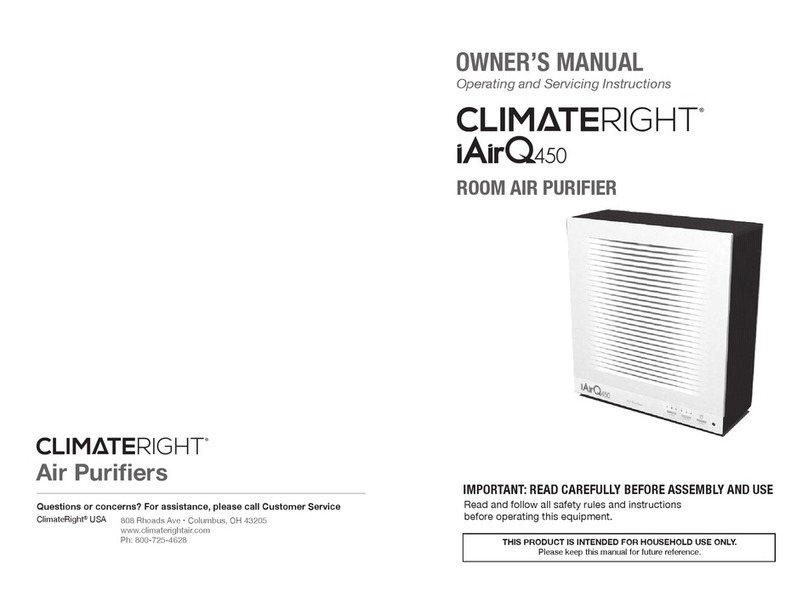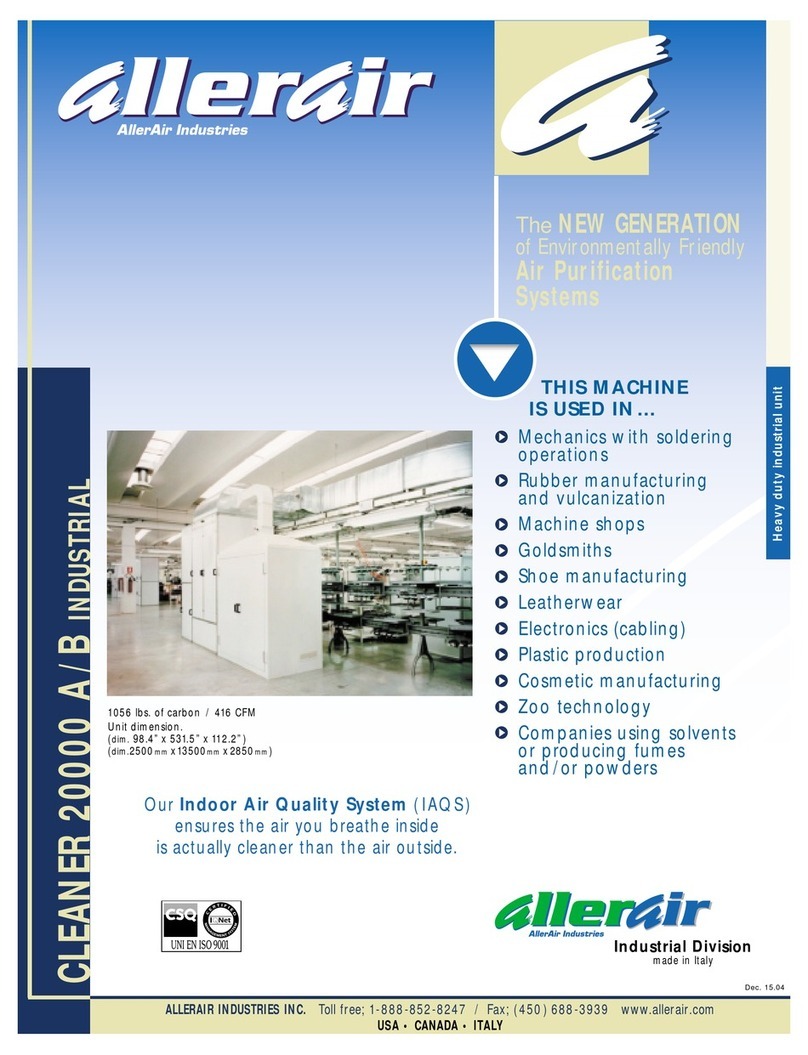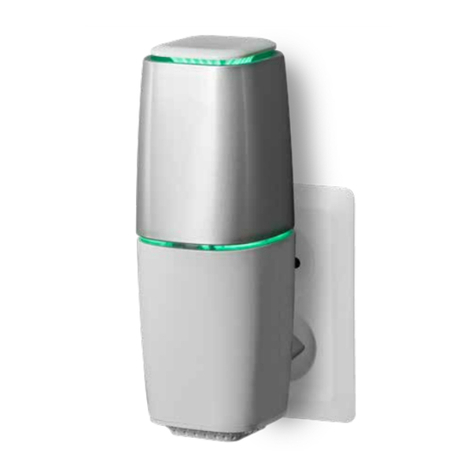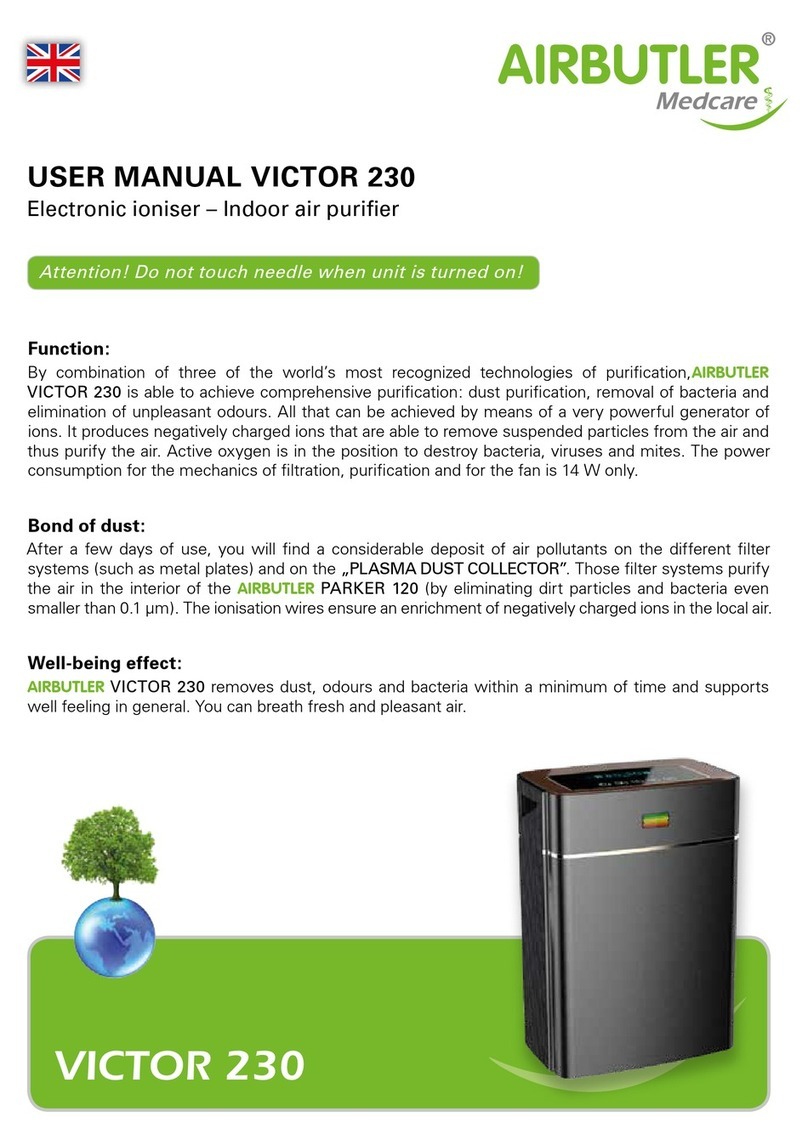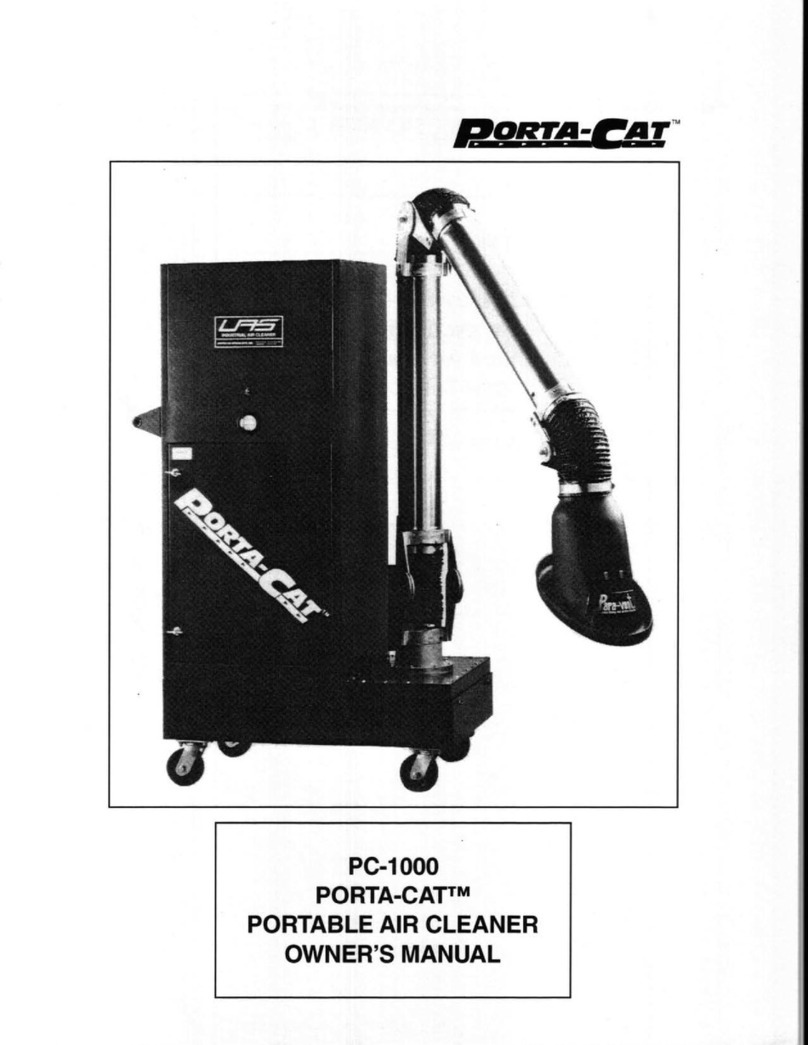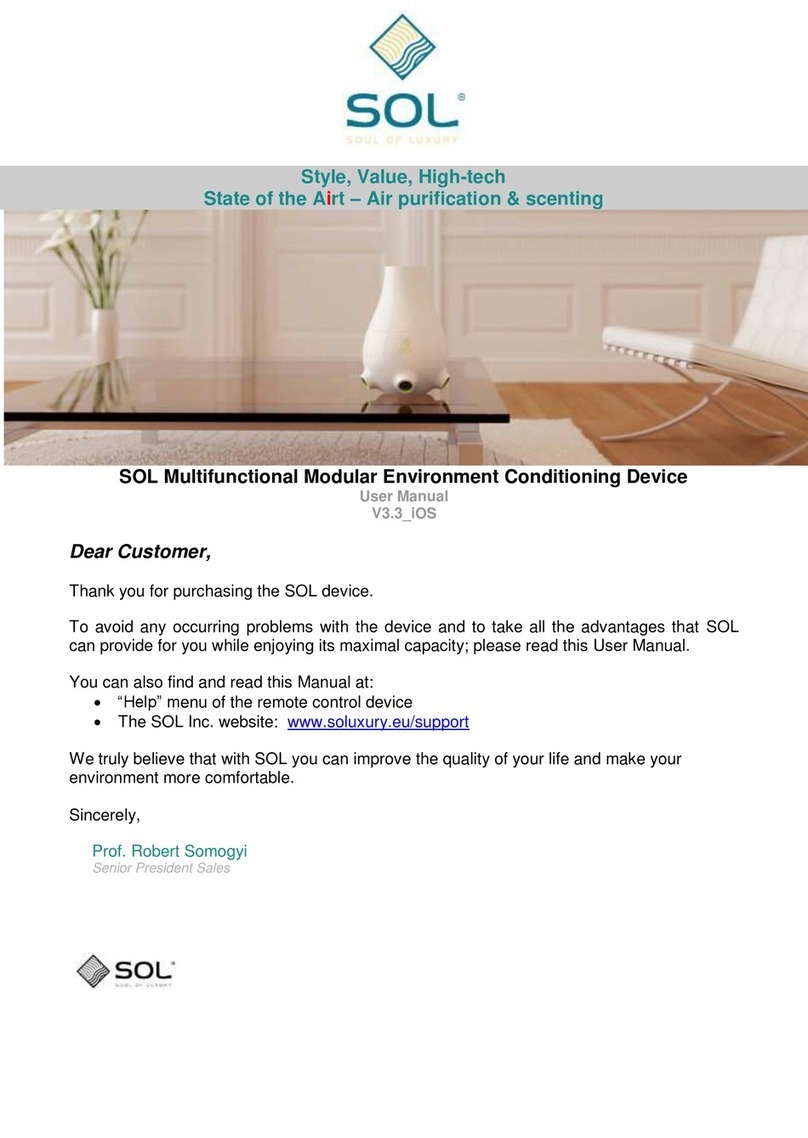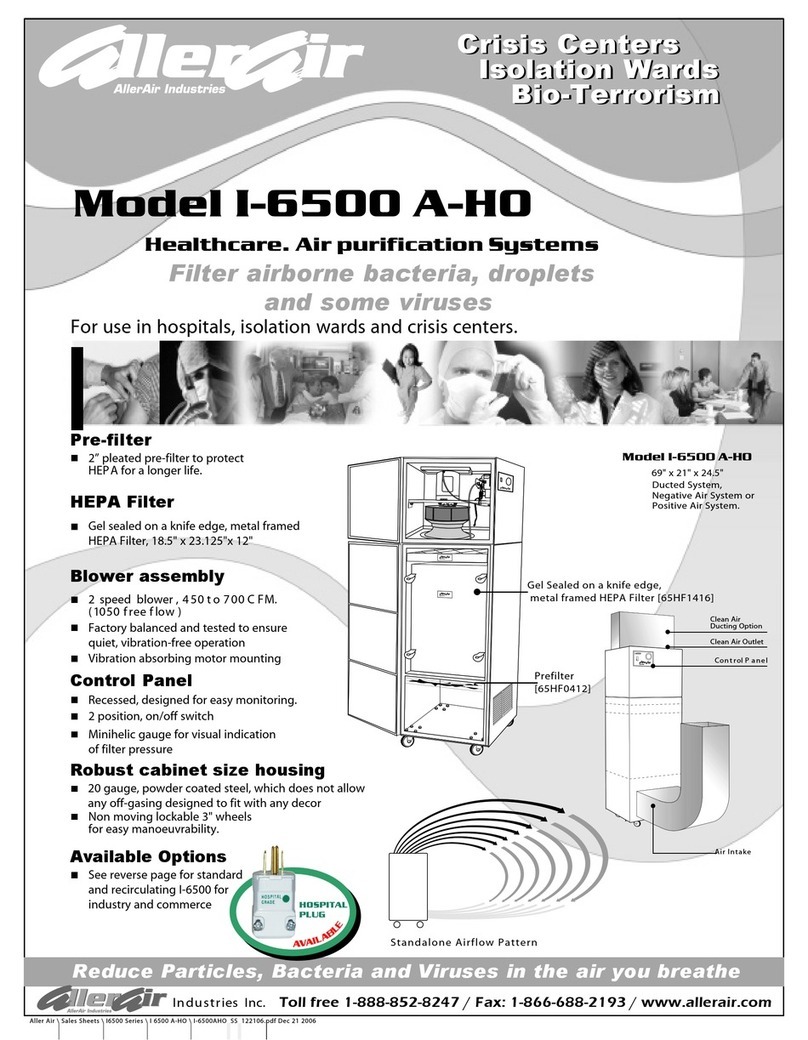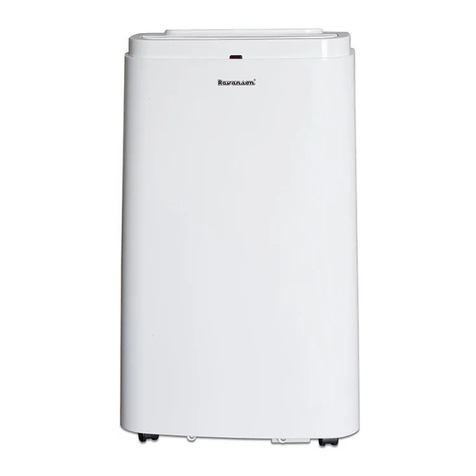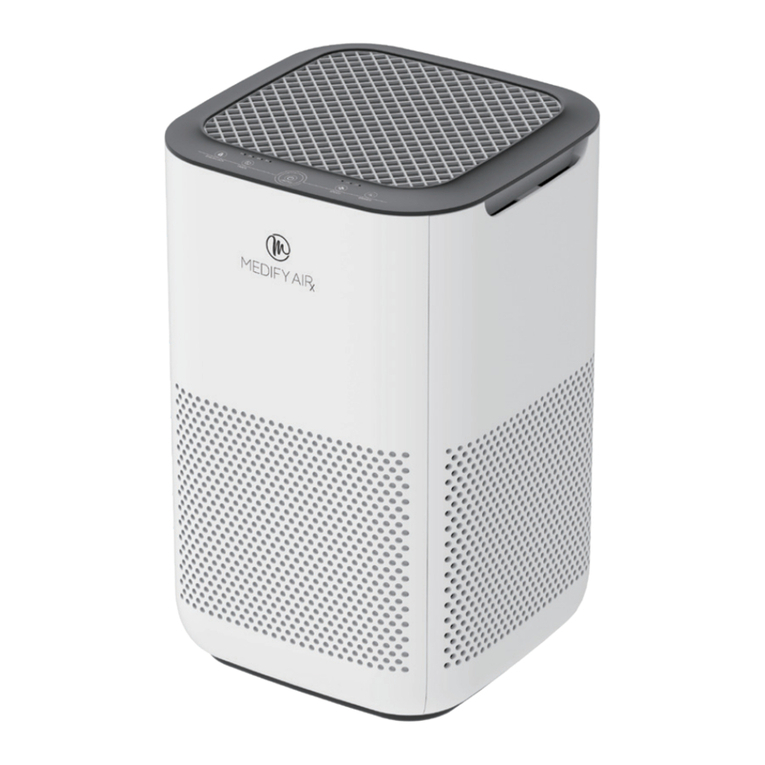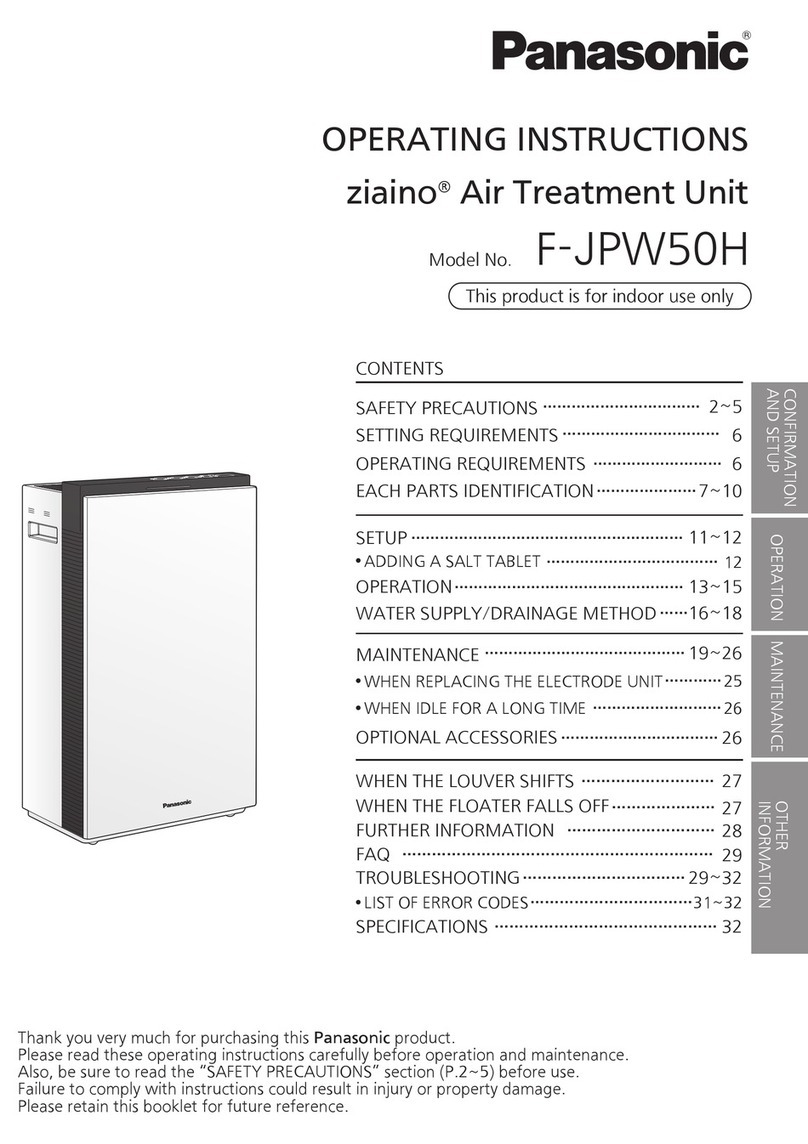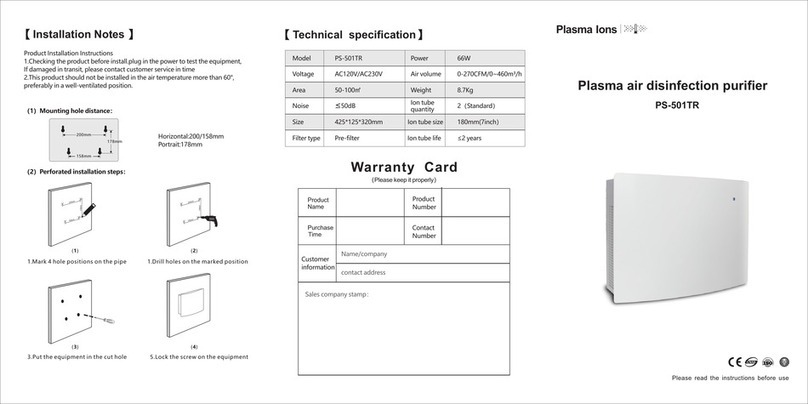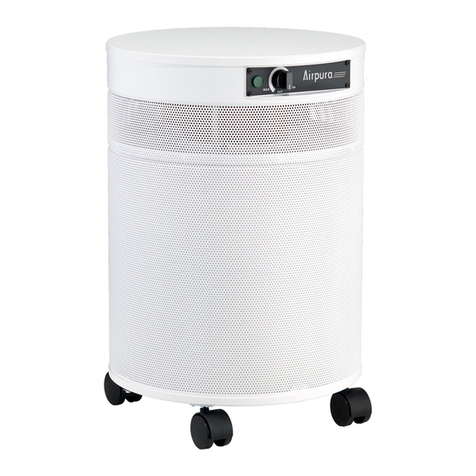Huawei FusionCol8000-E24 User manual

FusionCol8000-E240 Modular Indirect Evaporative
Cooling System
User Manual
Issue 03
Date 2021-04-20
HUAWEI DIGITAL POWER TECHNOLOGIES CO., LTD.

Copyright © Huawei Digital Power Technologies Co., Ltd. 2022. All rights reserved.
No part of this document may be reproduced or transmitted in any form or by any means without prior
written consent of Huawei Digital Power Technologies Co., Ltd.
Trademarks and Permissions
and other Huawei trademarks are the property of Huawei Technologies Co., Ltd.
All other trademarks and trade names mentioned in this document are the property of their respective
holders.
Notice
The purchased products, services and features are stipulated by the contract made between Huawei
Digital Power Technologies Co., Ltd. and the customer. All or part of the products, services and features
described in this document may not be within the purchase scope or the usage scope. Unless otherwise
specied in the contract, all statements, information, and recommendations in this document are
provided "AS IS" without warranties, guarantees or representations of any kind, either express or implied.
The information in this document is subject to change without notice. Every eort has been made in the
preparation of this document to ensure accuracy of the contents, but all statements, information, and
recommendations in this document do not constitute a warranty of any kind, express or implied.
Huawei Digital Power Technologies Co., Ltd.
Address: Huawei Digital Power Antuoshan Headquarters
Futian,Shenzhen 518043
People's Republic of China
Website: https://e.huawei.com
Issue 03 (2021-04-20) Copyright © Huawei Digital Power Technologies Co., Ltd. i

About This Document
Purpose
This document describes the FusionCol8000-E modular indirect evaporative
cooling system in terms of product overview, installation, power-on
commissioning, and operation and maintenance (O&M), providing systemic
knowledge of the FusionCol8000-E.
Intended Audience
● Sales engineers
● Technical support engineers
● System engineers
● Hardware installation engineers
● Commissioning engineers
● Data conguration engineers
● Maintenance engineers
Symbol Conventions
The symbols that may be found in this document are dened as follows.
Symbol Description
Indicates a hazard with a high level of risk which, if not
avoided, will result in death or serious injury.
Indicates a hazard with a medium level of risk which, if
not avoided, could result in death or serious injury.
Indicates a hazard with a low level of risk which, if not
avoided, could result in minor or moderate injury.
FusionCol8000-E240 Modular Indirect Evaporative
Cooling System
User Manual About This Document
Issue 03 (2021-04-20) Copyright © Huawei Digital Power Technologies Co., Ltd. ii

Symbol Description
Indicates a potentially hazardous situation which, if not
avoided, could result in equipment damage, data loss,
performance deterioration, or unanticipated results.
NOTICE is used to address practices not related to
personal injury.
Supplements the important information in the main
text.
NOTE is used to address information not related to
personal injury, equipment damage, and environment
deterioration.
Change History
Issue Date Description
03 2022-04-20 Updated 3.1 Technical Specications.
Updated 2.5 Working Modes.
Updated 12 Component Replacement.
Deleted the section about installing
electric heater components and cables
because electric heater components are
not supported.
02 2021-04-15 Building scenario: Added the oor drain
pipe.
Building scenario: Changed the positions
of water rell and drain pipe ports.
Optimized the content related to water
seals.
Building scenario: Updated 4.8
(Optional) Installing Motorized
Dampers and Cables.
Added a water pan and oat to the
precooling module.
Added the current of the unit and the
corresponding cable model selection.
Added the content about maintenance
for the precooling module and exhaust
fan.
Added 4.6 Installing an Air Deector
and 5.6 Installing an Air Deector.
01 2021-01-30 The issue is the rst ocial release.
FusionCol8000-E240 Modular Indirect Evaporative
Cooling System
User Manual About This Document
Issue 03 (2021-04-20) Copyright © Huawei Digital Power Technologies Co., Ltd. iii

Contents
About This Document................................................................................................................ ii
1 Safety Information.................................................................................................................. 1
1.1 General Safety.......................................................................................................................................................................... 1
1.2 Personnel Requirements....................................................................................................................................................... 4
1.3 Electrical Safety........................................................................................................................................................................4
1.4 Installation Environment Requirements.......................................................................................................................... 6
1.5 Mechanical Safety................................................................................................................................................................... 8
1.6 Cooling System Safety.........................................................................................................................................................10
1.7 Others....................................................................................................................................................................................... 11
2 Product Description.............................................................................................................. 12
2.1 Model Number Description............................................................................................................................................... 12
2.2 Components............................................................................................................................................................................ 13
2.2.1 Product Introduction (Building Scenario)................................................................................................................. 13
2.2.2 Product Introduction (FDC Scenario)......................................................................................................................... 17
2.3 Display Module...................................................................................................................................................................... 20
2.4 Main Control Module.......................................................................................................................................................... 23
2.5 Working Modes..................................................................................................................................................................... 25
3 Product Specications.......................................................................................................... 28
3.1 Technical Specications...................................................................................................................................................... 28
3.1.1 System Specications (Building Scenario)................................................................................................................ 28
3.1.2 System Specications (FDC Scenario)........................................................................................................................ 29
3.2 Operating Environment Specications.......................................................................................................................... 31
4 System Installation (Building Scenario).......................................................................... 33
4.1 Installation Requirements.................................................................................................................................................. 33
4.1.1 Installation Precautions................................................................................................................................................... 33
4.1.2 Space Requirements......................................................................................................................................................... 34
4.1.3 Storage Requirements......................................................................................................................................................34
4.2 Tools.......................................................................................................................................................................................... 35
4.3 Materials.................................................................................................................................................................................. 38
4.3.1 Water Rell Pipe and Drainpipe................................................................................................................................... 38
4.3.2 Cables.................................................................................................................................................................................... 39
4.4 Installing a Unit..................................................................................................................................................................... 39
FusionCol8000-E240 Modular Indirect Evaporative
Cooling System
User Manual Contents
Issue 03 (2021-04-20) Copyright © Huawei Digital Power Technologies Co., Ltd. iv

4.4.1 Unpacking and Checking................................................................................................................................................ 39
4.4.2 Securing a Unit................................................................................................................................................................... 40
4.4.3 Checking the Refrigerant................................................................................................................................................ 45
4.4.4 Installing Air Ducts............................................................................................................................................................45
4.4.5 Installing Pipes................................................................................................................................................................... 46
4.4.6 Removing Transport Fasteners and Desiccant Bags.............................................................................................. 49
4.5 Installing Cables.................................................................................................................................................................... 50
4.5.1 Precautions.......................................................................................................................................................................... 50
4.5.2 Cable Routes....................................................................................................................................................................... 51
4.5.3 (Optional) Installing Signal Cables............................................................................................................................. 51
4.5.4 (Optional) Installing Teamwork and Monitoring Communications Cables.................................................. 53
4.5.4.1 Preparing a Network Cable........................................................................................................................................ 54
4.5.4.2 CAN Teamwork + RS485 Monitoring...................................................................................................................... 54
4.5.4.3 CAN Teamwork + FE Monitoring..............................................................................................................................56
4.5.4.4 FE Teamwork + RS485 Monitoring.......................................................................................................................... 57
4.5.4.5 FE Teamwork + FE Monitoring.................................................................................................................................. 58
4.5.5 Installing Power Cables................................................................................................................................................... 60
4.6 Installing an Air Deector.................................................................................................................................................. 61
4.7 (Optional) Installing T/H Sensors Outside the Unit and Cables.......................................................................... 63
4.8 (Optional) Installing Motorized Dampers and Cables.............................................................................................65
5 System Installation (FDC Scenario).................................................................................. 67
5.1 Installation Requirements.................................................................................................................................................. 67
5.1.1 Installation Precautions................................................................................................................................................... 67
5.1.2 Space Requirements......................................................................................................................................................... 68
5.1.3 Storage Requirements......................................................................................................................................................68
5.2 Tools.......................................................................................................................................................................................... 69
5.3 Materials.................................................................................................................................................................................. 72
5.3.1 Water Rell Pipe and Drainpipe................................................................................................................................... 72
5.3.2 Cables.................................................................................................................................................................................... 73
5.4 Installing a Unit..................................................................................................................................................................... 73
5.4.1 Unpacking and Checking................................................................................................................................................ 73
5.4.2 Securing a Unit................................................................................................................................................................... 74
5.4.3 Checking the Refrigerant................................................................................................................................................ 76
5.4.4 Installing Air Ducts............................................................................................................................................................77
5.4.5 Installing Pipes................................................................................................................................................................... 78
5.4.6 Removing Transport Fasteners and Desiccant Bags.............................................................................................. 81
5.5 Installing Cables.................................................................................................................................................................... 82
5.5.1 Precautions.......................................................................................................................................................................... 82
5.5.2 (Optional) Installing Signal Cables............................................................................................................................. 82
5.5.3 Cable Routes....................................................................................................................................................................... 85
5.5.4 (Optional) Installing Teamwork and Monitoring Communications Cables.................................................. 85
5.5.4.1 Preparing a Network Cable........................................................................................................................................ 85
FusionCol8000-E240 Modular Indirect Evaporative
Cooling System
User Manual Contents
Issue 03 (2021-04-20) Copyright © Huawei Digital Power Technologies Co., Ltd. v

5.5.4.2 CAN Teamwork + RS485 Monitoring...................................................................................................................... 86
5.5.4.3 CAN Teamwork + FE Monitoring..............................................................................................................................88
5.5.4.4 FE Teamwork + RS485 Monitoring.......................................................................................................................... 89
5.5.4.5 FE Teamwork + FE Monitoring.................................................................................................................................. 90
5.5.5 Installing Power Cables................................................................................................................................................... 92
5.6 Installing an Air Deector.................................................................................................................................................. 93
5.7 (Optional) Installing T/H Sensors Outside the Unit and Cables.......................................................................... 94
5.8 (Optional) Installing Motorized Dampers and Cables.............................................................................................96
6 Verifying the Installation.................................................................................................... 98
7 Power-On Commissioning.................................................................................................101
7.1 Preparing for Power-On................................................................................................................................................... 101
7.2 Powering On the Unit....................................................................................................................................................... 101
7.3 Home Screen........................................................................................................................................................................ 111
7.4 Initial Conguration.......................................................................................................................................................... 113
7.4.1 Setting T/H Sensor Parameters.................................................................................................................................. 113
7.4.2 (Optional) Setting the Pressure Dierence Control............................................................................................116
7.4.3 (Optional) Setting Teamwork Parameters............................................................................................................. 116
7.4.4 Setting Communications Parameters.......................................................................................................................123
7.4.4.1 Setting Communications Parameters (Modbus-RTU Protocol)...................................................................123
7.4.4.2 Setting Communications Parameters (Modbus-TCP Protocol).................................................................... 124
7.4.4.3 Setting Communications Parameters (SNMP Protocol).................................................................................125
7.5 Startup....................................................................................................................................................................................128
7.6 Wizard Startup.................................................................................................................................................................... 130
7.7 (Optional) Power-O........................................................................................................................................................132
7.8 Checking After Commissioning......................................................................................................................................133
8 WebUI.................................................................................................................................... 134
8.1 Preparations and WebUI Login......................................................................................................................................134
8.2 Introduction to the WebUI.............................................................................................................................................. 137
9 System Maintenance.......................................................................................................... 138
9.1 Routine Maintenance Overview.................................................................................................................................... 138
9.2 Routine Maintenance........................................................................................................................................................ 139
9.2.1 Monthly Maintenance................................................................................................................................................... 139
9.2.2 Quarterly Maintenance................................................................................................................................................. 141
9.2.3 Yearly Maintenance........................................................................................................................................................ 142
10 Troubleshooting................................................................................................................ 144
11 Alarm Reference................................................................................................................151
12 Component Replacement............................................................................................... 152
12.1 Component Position (Building Scenario).................................................................................................................152
12.2 Component Position (FDC Scenario).........................................................................................................................153
12.3 Replacing an Air Filter (Building Scenario).............................................................................................................153
FusionCol8000-E240 Modular Indirect Evaporative
Cooling System
User Manual Contents
Issue 03 (2021-04-20) Copyright © Huawei Digital Power Technologies Co., Ltd. vi

12.4 Replacing an Air Filter (FDC Scenario).....................................................................................................................156
12.5 Replacing a Dierential Pressure Switch (Building Scenario).......................................................................... 157
12.6 Replacing a Dierential Pressure Switch (FDC Scenario).................................................................................. 159
12.7 Replacing a T/H Sensor (Building Scenario).......................................................................................................... 161
12.8 Replacing a T/H Sensor (FDC Scenario).................................................................................................................. 162
12.9 Replacing an Air Exhaust NTC Temperature Sensor (Building Scenario)..................................................... 164
12.10 Replacing an Air Exhaust NTC Temperature Sensor (FDC Scenario)...........................................................166
12.11 Replacing an Air Supply NTC Temperature Sensor............................................................................................ 166
12.12 Replacing an Air Supply Fan...................................................................................................................................... 168
12.13 Replacing an Exhaust Fan...........................................................................................................................................171
12.14 Replacing a Precooling Module................................................................................................................................ 174
12.15 Replacing a Compressor.............................................................................................................................................. 176
12.15.1 Replacing a Compressor.......................................................................................................................................... 176
12.15.2 R410A Refrigerant...................................................................................................................................................... 179
12.15.3 Leakage Test with Nitrogen for Refrigerant Pipes.......................................................................................... 181
12.15.4 Vacuumizing and Precharging Refrigerant........................................................................................................182
12.15.4.1 Refrigerant Charge Amount Requirements................................................................................................... 183
12.15.4.2 Vacuumizing............................................................................................................................................................. 183
12.15.4.3 Precharging Refrigerant........................................................................................................................................184
12.15.5 Charging the Remaining Refrigerant...................................................................................................................186
12.16 Replacing a Filter Dryer............................................................................................................................................... 187
12.17 Replacing a Compressor Drive.................................................................................................................................. 189
12.18 Replacing a Fan Drive.................................................................................................................................................. 191
12.19 Replacing a Liquid Level Sensor............................................................................................................................... 192
12.20 Replacing a Water Pump............................................................................................................................................ 194
12.21 Replacing a Switch........................................................................................................................................................ 195
12.22 Replacing a Contactor..................................................................................................................................................197
12.23 Replacing an SPD...........................................................................................................................................................198
12.24 Replacing a Fuse............................................................................................................................................................ 199
12.25 Replacing a Relay.......................................................................................................................................................... 199
13 FAQ....................................................................................................................................... 202
13.1 Operations with a USB Flash Drive............................................................................................................................202
13.1.1 How Do I Export Data?...............................................................................................................................................203
13.1.2 How Do I Import and Export a Conguration File?......................................................................................... 204
13.1.3 How Do I Import a Certicate and Key?.............................................................................................................. 205
13.2 Display Module Screen Operations............................................................................................................................206
13.2.1 How Do I Set LAN Parameters?...............................................................................................................................206
13.2.2 How Do I Check Temperature and Humidity Curves?..................................................................................... 207
13.2.3 How Do I View Logs?.................................................................................................................................................. 208
13.2.4 How Do I View Component Status?.......................................................................................................................208
13.2.5 How Do I View System Parameters?..................................................................................................................... 208
13.2.6 How Do I View Version Information?.................................................................................................................... 209
FusionCol8000-E240 Modular Indirect Evaporative
Cooling System
User Manual Contents
Issue 03 (2021-04-20) Copyright © Huawei Digital Power Technologies Co., Ltd. vii

13.2.7 How Do I View the Service Information?............................................................................................................. 209
13.2.8 How Do I Check Teamwork Control Information?............................................................................................ 209
13.2.9 How Do I Mute or Silence a Buzzer?..................................................................................................................... 210
13.2.10 How Do I Handle Alarms?...................................................................................................................................... 210
13.2.11 How Do I Clear Component Runtime?............................................................................................................... 211
13.2.12 How Do I Calibrate a T/H Sensor?....................................................................................................................... 211
13.2.13 How Do I Check the Display of Normal Air Volume?................................................................................... 212
13.2.14 How Do I Check Whether Group Upgrade Is Supported in a Scenario?................................................. 214
13.2.15 How Do I Change the Password?......................................................................................................................... 214
13.2.16 How Do I Set the Balance of Water and Electricity Consumption?......................................................... 215
13.2.17 How Do I Set Alarm Parameters?.........................................................................................................................215
13.2.18 How Do I Commission a Component?................................................................................................................217
13.2.19 How Do I Query the Setting of a Parameter Before Change?................................................................... 218
13.3 WebUI Operations........................................................................................................................................................... 218
13.3.1 How Do I Manage WebUI Users?........................................................................................................................... 218
13.3.2 How Do I Install a Network Security Certicate?............................................................................................. 220
13.3.3 How Do I View Active Alarms and Historical Alarms?.................................................................................... 221
13.3.4 How Do I Export or Import a Conguration File?.............................................................................................221
13.3.5 How Do I Export Fault Information?..................................................................................................................... 222
13.3.6 How Do I Change an IP Address?........................................................................................................................... 222
13.3.7 How Do I View Version Information?.................................................................................................................... 223
A Cleaning the Unit............................................................................................................... 224
B Repainting the Unit............................................................................................................225
C Cooling System Layout...................................................................................................... 231
D Electrical Conceptual Diagrams...................................................................................... 232
E Air lter Maintenance Platform...................................................................................... 240
F Physical Ports (Building Scenario).................................................................................. 241
F.1 Physical Ports of Air Vents............................................................................................................................................... 241
F.2 Physical Ports of Pipes....................................................................................................................................................... 245
F.3 Physical Ports of Cables.................................................................................................................................................... 246
G Physical Ports (FDC Scenario)......................................................................................... 249
G.1 Physical Ports of Air Vents.............................................................................................................................................. 249
G.2 Physical Ports of Pipes..................................................................................................................................................... 254
G.3 Physical Ports of Cables................................................................................................................................................... 256
H Acronyms and Abbreviations...........................................................................................259
FusionCol8000-E240 Modular Indirect Evaporative
Cooling System
User Manual Contents
Issue 03 (2021-04-20) Copyright © Huawei Digital Power Technologies Co., Ltd. viii

1 Safety Information
1.1 General Safety
Statement
Before installing, operating, and maintaining the equipment, carefully read this
document and observe all safety instructions provided herein and written on the
equipment itself.
The "NOTICE", "CAUTION", "WARNING", and "DANGER" statements in this
document do not cover all the safety instructions. They are only supplements to
the safety instructions. The Company will not be liable for any consequence
caused by the violation of general safety requirements or design, production, and
usage safety standards.
Ensure that the equipment is used in environments that meet its design
specications. Otherwise, the equipment may become faulty, and the resulting
equipment malfunction, component damage, personal injuries, or property
damage will not be covered under the warranty.
Follow local laws and regulations when installing, operating, or maintaining the
equipment. The safety instructions in this document are only supplements to local
laws and regulations.
The Company will not be liable for any consequences of the following
circumstances:
● Operation beyond the conditions specied in this document
● Installation or use in environments which are not specied in relevant
international or national standards
● Unauthorized modications to the product or software code or removal of the
product
● Failure to follow the operation instructions and safety precautions on the
product and in this document
● Equipment damage due to force majeure, such as earthquakes, re, and
storms
FusionCol8000-E240 Modular Indirect Evaporative
Cooling System
User Manual 1 Safety Information
Issue 03 (2021-04-20) Copyright © Huawei Digital Power Technologies Co., Ltd. 1

● Damage caused during transportation by the customer
● Storage conditions that do not meet the requirements specied in this
document
General Requirements
● Do not install, use, or operate outdoor equipment and cables (including but
not limited to moving equipment, operating equipment and cables, inserting
connectors to or removing connectors from signal ports connected to outdoor
facilities, working at heights, and performing outdoor installation) in harsh
weather conditions such as lightning, rain, snow, and level 6 or stronger wind.
● Before installing, operating, or maintaining the equipment, remove any
conductive objects such as watches or metal jewelry like bracelets, bangles,
and rings to avoid electric shock.
● When installing, operating, or maintaining the equipment, wear dedicated
protective gears such as insulation gloves, goggles, and safety clothing,
helmet, and shoes, as shown in the following gure.
● Follow the specied procedures for installation, operation, and maintenance.
● Before handling a conductor surface or terminal, measure the contact point
voltage and ensure that there is no risk of electric shock.
● After installing the equipment, remove idle packing materials such as cartons,
foam, plastics, and cable ties from the equipment area.
● In the case of a re, immediately leave the building or the equipment area
and activate the re alarm or call emergency services. Do not re-enter the
building or aected area until it has been deemed safe by qualied
professionals.
● Do not stop using protective devices. Pay attention to the warnings, cautions,
and related precautionary measures in this document and on the equipment.
Promptly replace warning labels that have worn out.
● Keep irrelevant people away from the equipment. Only operators are allowed
to access the equipment.
● Use insulated tools or tools with insulated handles, as shown in the following
gure.
FusionCol8000-E240 Modular Indirect Evaporative
Cooling System
User Manual 1 Safety Information
Issue 03 (2021-04-20) Copyright © Huawei Digital Power Technologies Co., Ltd. 2

● All cable holes should be sealed. Seal the used cable holes with restop putty.
Seal the unused cable holes with the caps delivered with the cabinet. The
following gure shows the criteria for correct sealing with restop putty.
● Do not scrawl, damage, or block any warning label on the equipment.
● When installing the equipment, use a torque wrench with a proper range to
tighten the screws. When using a wrench to tighten the screws, ensure that
the wrench does not tilt and the torque error does not exceed 10% of the
specied value.
● Do not work with power on during installation.
● Repaint any paint scratches caused during equipment transportation or
installation in a timely manner. Equipment with scratches cannot be exposed
to an outdoor environment for an extended period of time.
● Before operations, ensure that the equipment is rmly secured to the oor or
other solid objects, such as a wall or an installation rack.
● Do not use water to clean electrical components inside or outside of a
cabinet.
● Do not change the structure or installation sequence of equipment without
permission.
● Do not touch a running fan with your ngers, components, screws, tools, or
boards before the fan is powered o or stops running.
FusionCol8000-E240 Modular Indirect Evaporative
Cooling System
User Manual 1 Safety Information
Issue 03 (2021-04-20) Copyright © Huawei Digital Power Technologies Co., Ltd. 3

Personal Safety
● If there is a likelihood of personal injury or equipment damage during
operations, immediately stop, report the case to the supervisor, and take
feasible protective measures.
● To avoid electric shock, do not connect safety extra-low voltage (SELV) circuits
to telecommunication network voltage (TNV) circuits.
● Do not power on the equipment before it is installed or conrmed by
professionals.
1.2 Personnel Requirements
● Personnel who plan to install or maintain the equipment must receive
thorough training, understand all necessary safety precautions, and be able to
correctly perform all operations.
● Only qualied professionals or trained personnel are allowed to install,
operate, and maintain the equipment.
● Only qualied professionals are allowed to remove safety facilities and inspect
the equipment.
● Personnel who will operate the equipment, including operators, trained
personnel, and professionals, should possess the local national required
qualications in special operations such as high-voltage operations, working
at heights, and operations of special equipment.
● Professionals: personnel who are trained or experienced in equipment
operations and are clear of the sources and degree of various potential
hazards in equipment installation, operation, maintenance
● Trained personnel: personnel who are technically trained, have required
experience, are aware of possible hazards on themselves in certain operations,
and are able to take protective measures to minimize the hazards on
themselves and other people
● Operators: operation personnel who may come in contact with the
equipment, except trained personnel and professionals
● Only professionals or authorized personnel are allowed to replace the
equipment or components (including software).
1.3 Electrical Safety
Grounding
● For the equipment that needs to be grounded, install the ground cable rst
when installing the equipment and remove the ground cable last when
removing the equipment.
● Do not damage the ground conductor.
● Do not operate the equipment in the absence of a properly installed ground
conductor.
● Ensure that the equipment is connected permanently to the protective
ground. Before operating the equipment, check its electrical connection to
ensure that it is securely grounded.
FusionCol8000-E240 Modular Indirect Evaporative
Cooling System
User Manual 1 Safety Information
Issue 03 (2021-04-20) Copyright © Huawei Digital Power Technologies Co., Ltd. 4

General Requirements
Use dedicated insulated tools when performing high-voltage operations.
AC and DC Power
D ANGER
Do not connect or disconnect power cables with power on. Transient contact
between the core of the power cable and the conductor will generate electric arcs
or sparks, which may cause re or personal injury.
● If a "high electricity leakage" tag is attached on the equipment, ground the
protective ground terminal on the equipment enclosure before connecting the
AC power supply; otherwise, electric shock as a result of electricity leakage
may occur.
● Before installing or removing a power cable, turn o the power switch.
● Before connecting a power cable, check that the label on the power cable is
correct.
● If the equipment has multiple inputs, disconnect all the inputs before
operating the equipment.
● A circuit breaker equipped with a residual current device (RCD) is not
recommended.
● A damaged power cable must be replaced by the manufacturer, service agent,
or professionals to avoid risks.
● High voltage operations and installation of AC-powered facilities must be
performed by qualied personnel.
Cabling
● When routing cables, ensure that a distance of at least 30 mm exists between
the cables and heat-generating components or areas. This prevents damage
to the insulation layer of the cables.
● Do not route cables behind the air intake and exhaust vents of the
equipment.
● Ensure that cables meet the VW-1 or ZB ame spread rating requirements or
higher.
● Bind cables of the same type together. When routing cables of dierent types,
ensure that they are at least 30 mm away from each other.
● If an AC input power cable is connected to the cabinet from the top, bend the
cable in a U shape outside the cabinet and then route it into the cabinet.
● When the temperature is low, violent impact or vibration may damage the
plastic cable sheathing. To ensure safety, comply with the following
requirements:
– Cables can be laid or installed only when the temperature is higher than
0°C. Handle cables with caution, especially at a low temperature.
– Cables stored at subzero temperatures must be stored at room
temperature for at least 24 hours before they are laid out.
FusionCol8000-E240 Modular Indirect Evaporative
Cooling System
User Manual 1 Safety Information
Issue 03 (2021-04-20) Copyright © Huawei Digital Power Technologies Co., Ltd. 5

● Do not perform any improper operations, for example, dropping cables
directly from a vehicle.
● When selecting, connecting, and routing cables, follow local safety regulations
and rules.
ESD
NO TICE
The static electricity generated by human bodies may damage the electrostatic-
sensitive components on boards, for example, the large-scale integrated (LSI)
circuits.
● Wear ESD gloves or a well-grounded ESD wrist strap when touching the
device or handling boards or application-specic integrated circuits (ASICs).
● When holding a board, hold its edge without touching any components. Do
not touch the components with your bare hands.
● Package boards with ESD packaging materials before storing or transporting
them.
Figure 1-1 Wearing an ESD wrist strap
Neutral-Ground Voltage
It is recommended that the three-phase loads be equalized and the neutral-
ground voltage be kept at less than 2 V to meet power distribution requirements.
1.4 Installation Environment Requirements
● To prevent re due to high temperature, ensure that the ventilation vents or
heat dissipation system are not blocked when the equipment is running.
● Install the equipment in an area far away from liquids. Do not install it under
areas prone to condensation, such as under water pipes and air exhaust vents,
or areas prone to water leakage, such as air conditioner vents, ventilation
FusionCol8000-E240 Modular Indirect Evaporative
Cooling System
User Manual 1 Safety Information
Issue 03 (2021-04-20) Copyright © Huawei Digital Power Technologies Co., Ltd. 6

vents, or feeder windows of the equipment room. Ensure that no liquid enters
the equipment to prevent faults or short circuits.
● If any liquid is detected inside the equipment, immediately disconnect the
power supply and contact the administrator.
● Do not expose the equipment to ammable or explosive gas or smoke. Do
not perform any operation on the equipment in such environments.
● Ensure that the equipment room provides good heat insulation, and the walls
and oor are dampproof.
● Install a rat guard at the door of the equipment room.
Installation at Heights
● Working at heights refers to operations that are performed at least 2 meters
above the ground.
● Do not work at heights if the steel pipes are wet or other potential danger
exists. After the preceding conditions no longer exist, the safety director and
relevant technical personnel need to check the involved equipment. Operators
can begin working only after obtaining consent.
● When working at heights, comply with local relevant laws and regulations.
● Only trained and qualied personnel are allowed to work at heights.
● Before working at heights, check the climbing tools and safety gears such as
safety helmets, safety belts, ladders, springboards, scaolding, and lifting
equipment. If they do not meet the requirements, take corrective measures or
disallow working at heights.
● Wear personal protective equipment such as the safety helmet and safety belt
or waist rope and fasten it to a solid structure. Do not mount it on an
insecure moveable object or metal object with sharp edges. Make sure that
the hooks will not slide o.
● Set a restricted area and eye-catching signs for working at heights to warn
away irrelevant personnel.
● Carry the operation machinery and tools properly to prevent them from
falling o and causing injuries.
● Personnel involving working at heights are not allowed to throw objects from
the height to the ground, or vice versa. Objects should be transported by
tough slings, hanging baskets, highline trolleys, or cranes.
● Ensure that guard rails and warning signs are set at the edges and openings
of the area involving working at heights to prevent falls.
● Do not pile up scaolding, springboards, or other sundries on the ground
under the area involving working at heights. Do not allow people to stay or
pass under the area involving working at heights.
● Inspect the scaolding, springboards, and workbenches used for working at
heights in advance to ensure that their structures are solid and not
overloaded.
● Any violations must be promptly pointed out by the site manager or safety
supervisor and the involved personnel should be prompted for correction.
Personnel who fail to stop violations will be forbidden from working.
FusionCol8000-E240 Modular Indirect Evaporative
Cooling System
User Manual 1 Safety Information
Issue 03 (2021-04-20) Copyright © Huawei Digital Power Technologies Co., Ltd. 7

1.5 Mechanical Safety
Hoisting
● Do not walk under hoisted objects.
● Only trained and qualied personnel should perform hoisting operations.
● Check that hoisting tools are available and in good condition.
● Before hoisting objects, ensure that hoisting tools are rmly secured onto a
load-bearing object or wall.
● Ensure that the angle formed by two hoisting cables is no more than 90
degrees, as shown in the following gure.
● Do not drag steel ropes and hoisting tools or bump hoisted objects against
hard objects during hoisting.
Using Ladders
● Use wooden or berglass ladders when you need to perform live working at
heights.
● When a step ladder is used, ensure that the pull ropes are secured and the
ladder is held rm.
● Before using a ladder, check that it is intact and conrm its load bearing
capacity. Do not overload it.
● Ensure that the ladder is securely positioned. The recommended angle for a
ladder against the oor is 75 degrees, as shown in the following gure. An
angle rule can be used to measure the angle. Ensure that the wider end of the
ladder is at the bottom, or protective measures have been taken at the
bottom to prevent the ladder from sliding.
FusionCol8000-E240 Modular Indirect Evaporative
Cooling System
User Manual 1 Safety Information
Issue 03 (2021-04-20) Copyright © Huawei Digital Power Technologies Co., Ltd. 8

● When climbing a ladder, take the following precautions to reduce risks and
ensure safety:
– Keep your body steady.
– Do not climb higher than the fourth rung of the ladder from the top.
– Ensure that your body's center of gravity does not shift outside the legs
of the ladder.
Drilling Holes
When drilling holes into a wall or oor, observe the following safety precautions:
NO TICE
Do not drill holes into the equipment. Doing so may aect the electromagnetic
shielding of the equipment and damage components or cables inside. Metal
shavings from drilling may short-circuit boards inside the equipment.
● Obtain consent from the customer and contractor before drilling holes.
● Wear goggles and protective gloves when drilling holes.
● When drilling holes, protect the equipment from shavings. After drilling, clean
up any shavings that have accumulated inside or outside the equipment.
Moving Heavy Objects
D ANGER
When pulling the equipment out of a cabinet, be aware of unstable or heavy
objects on the cabinet to prevent injury.
● Be cautious to avoid injury when moving heavy objects.
FusionCol8000-E240 Modular Indirect Evaporative
Cooling System
User Manual 1 Safety Information
Issue 03 (2021-04-20) Copyright © Huawei Digital Power Technologies Co., Ltd. 9

● When moving the equipment by hand, wear protective gloves to prevent
injuries.
● Move or lift the equipment by holding its handles or lower edges. Do not hold
the handles of modules (such as power supply units, fans, and boards) that
are installed in the equipment because they cannot support the weight of the
equipment.
● Avoid scratching the cabinet surface or damaging cabinet components and
cables during equipment transportation.
● When transporting the equipment using a forklift truck, ensure that the forks
are properly positioned so that the equipment does not topple. Before moving
the equipment, secure it to the forklift truck using ropes. When moving the
equipment, assign dedicated personnel to take care of it.
● Choose a road with good conditions or sea for transportation to ensure
equipment safety. Avoid tilt or jolt during transportation.
● Move the cabinet with caution. Any bumping or falling may damage the
equipment.
1.6 Cooling System Safety
Welding
● At least two persons are required on a welding site.
● A welder must have a work permit.
● A welding site must be free from inammables.
● Ensure that a re extinguisher, wet wiper, and water container are available.
● A burning welding torch must not be placed on a component or on the oor,
and must not be placed in a metal container with acetylene and oxygen.
Otherwise, the gas may leak and cause a re.
● High-temperature pipes after welding must be promptly cooled.
● Do not weld or cut on pressurized containers or pipes. Electric devices must be
powered o before welding.
High Temperature and Pressure
● When maintaining or replacing components, pay attention to high-
temperature components (such as the compressor, refrigerant pipe, and
electric heater) to prevent scalds.
● When maintaining or replacing components, pay attention to high-pressure
components (such as the compressor and refrigerant pipe) to prevent the
refrigerant system from being cracked or exploded due to misoperations.
FusionCol8000-E240 Modular Indirect Evaporative
Cooling System
User Manual 1 Safety Information
Issue 03 (2021-04-20) Copyright © Huawei Digital Power Technologies Co., Ltd. 10

Refrigerant Frostbite
Refrigerant leakage may cause frostbite. Take protective measures (for example,
wear antifreeze gloves) when handling refrigerant.
Storage and Recycling
● Do not store devices near a heat source or under direct sunshine.
● Keep devices away from re or high-temperature objects, especially devices
injected with pressurized nitrogen or refrigerant; otherwise, explosion or
refrigerant leakage may occur, causing personal injury.
● The sign indicates that the product cannot be disposed of with other
wastes that have a shell in European Union (EU) areas. To avoid environment
pollution and harm to human health, wastes must be classied and recycled.
This also promotes resource reuse. When recycling a device, ll in the device
information in the recycling collection system or contact your dealer for help.
The dealer can help you recycle devices in a safe and environment-friendly
way.
1.7 Others
Exercise caution when shutting down the smart cooling product. Doing so may
cause equipment and room overheating, which will damage the equipment.
FusionCol8000-E240 Modular Indirect Evaporative
Cooling System
User Manual 1 Safety Information
Issue 03 (2021-04-20) Copyright © Huawei Digital Power Technologies Co., Ltd. 11
This manual suits for next models
1
Table of contents

